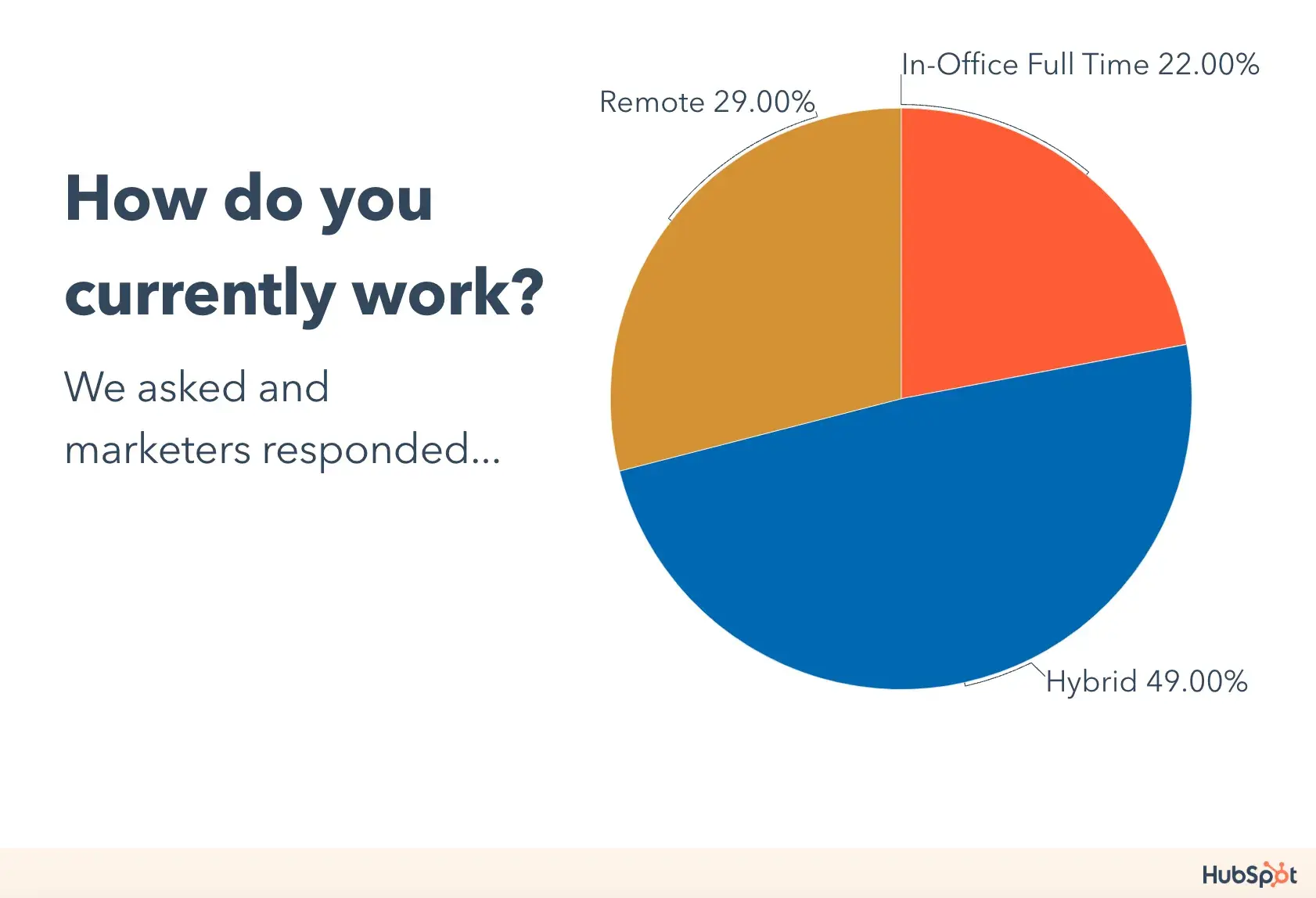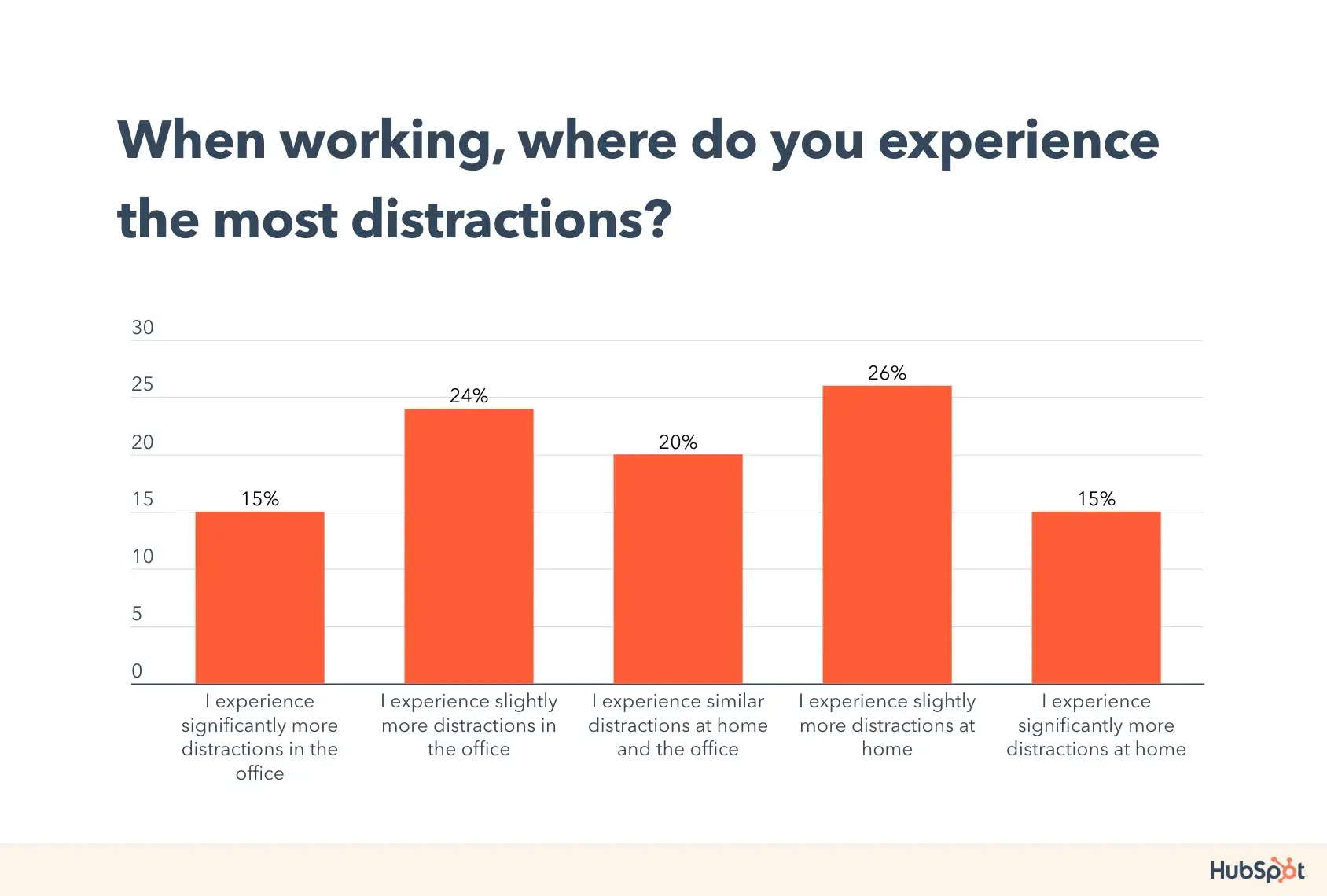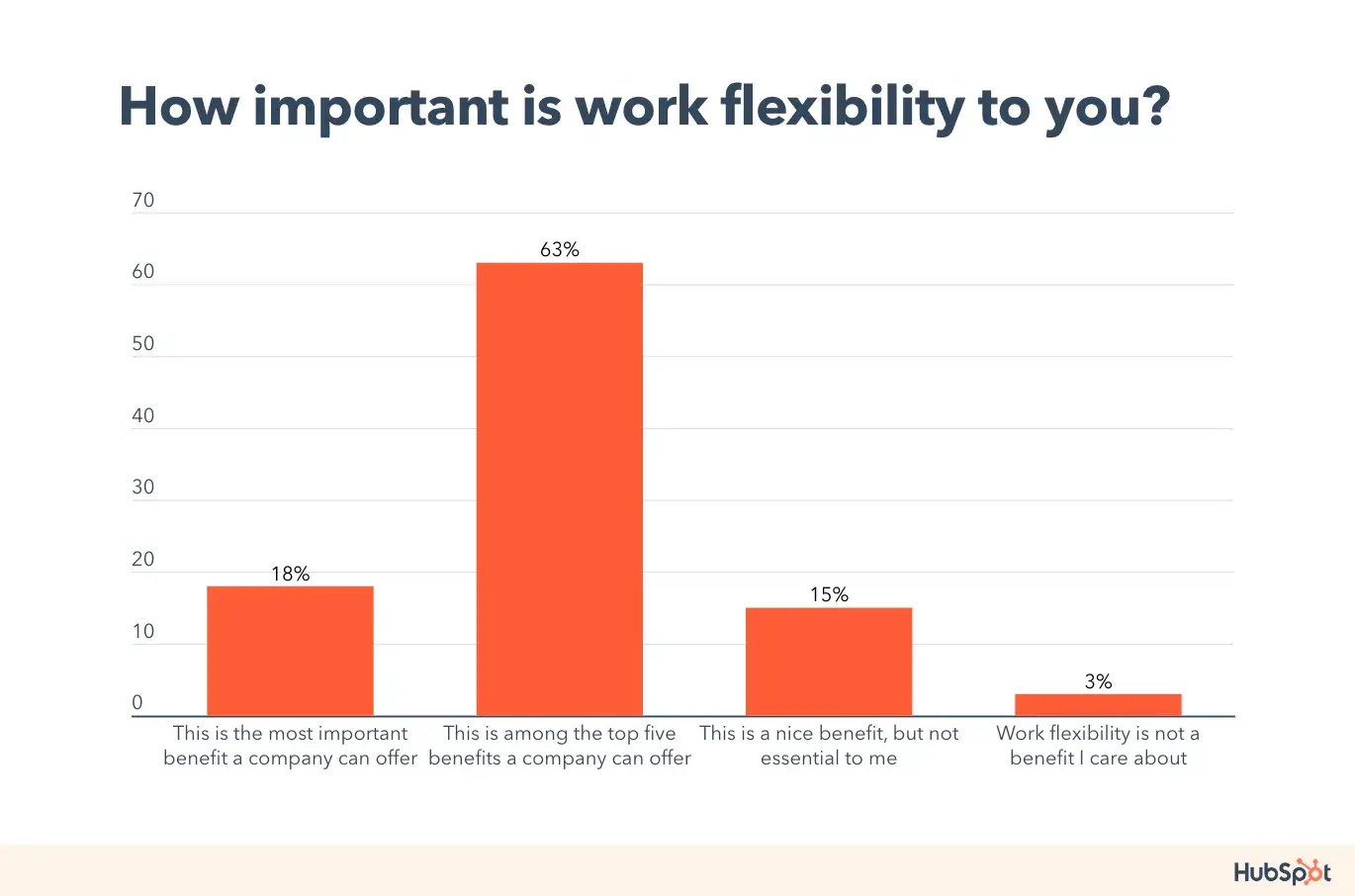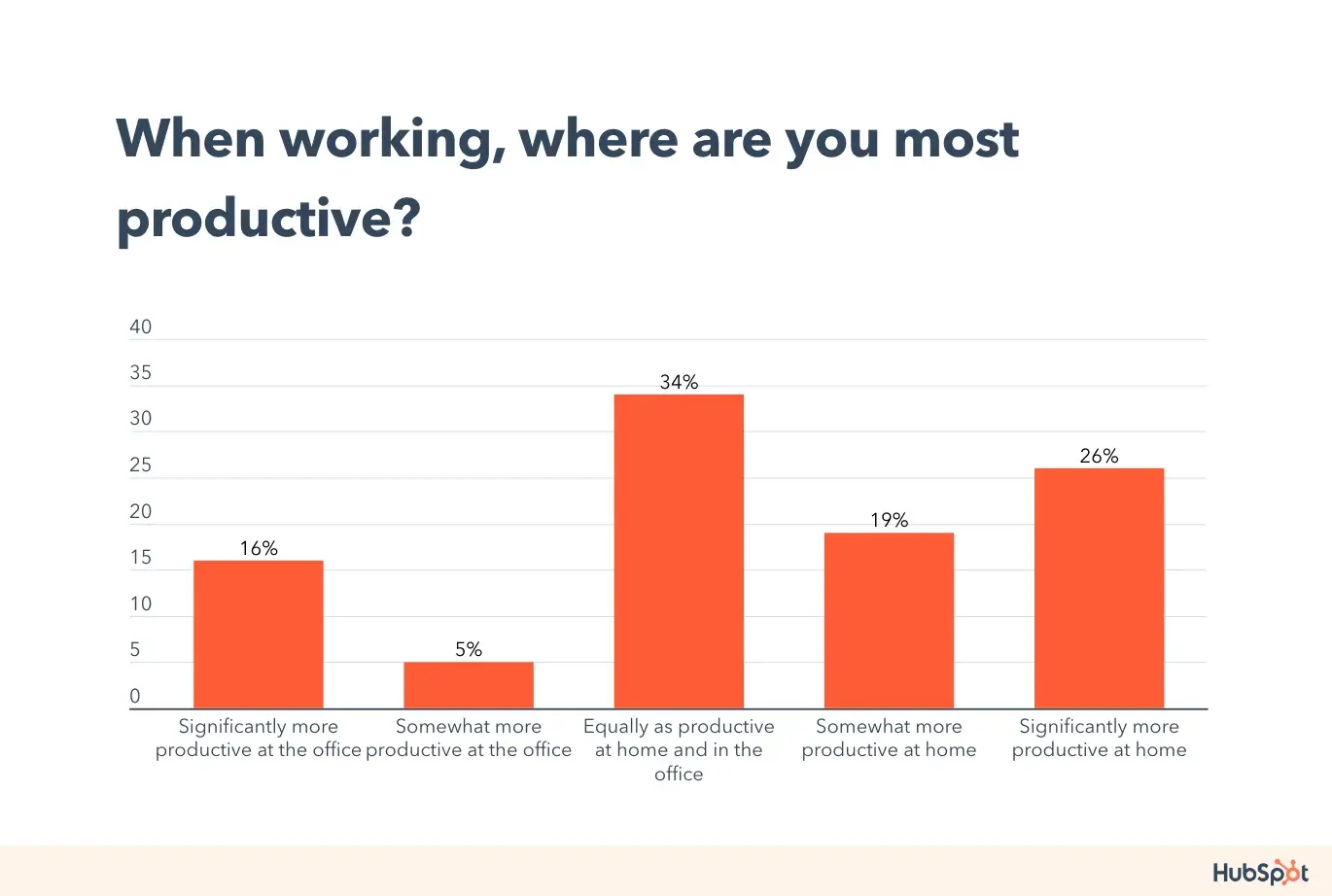The remote work productivity debate will never end, and frankly, it shouldn’t.

Leaders and employees alike should never stop being critical of how time is spent and seeking improved productivity levels.
Is it tiring to refine and edit how we work constantly? Sure. Change is always tiring to a degree, but thankfully, marketers are resilient to change because it’s inherent to what we do.
I feel like I’ve lived nine lives as a marketer: unpaid intern, salaried in-office employee, hybrid worker, remote contractor.
Most of my experience has been completed outside of the office setting, and as a remote work enthusiast and author, I prefer it that way for my productivity and quality of life. But am I the norm? Where are other marketers most productive?
I asked more than 100 marketers if they feel more productive (and happier) working in the office or at home. Here’s what they had to say.
Table of Contents
Remote, Hybrid, In-Office: The Marketing Landscape Today
Today, millions of marketers are showing up to work across the globe. How are they working? These are the three main organizational models.

Fully In-Office Teams
The concept of a fully in-office team doesn‘t need much of an introduction. Despite remote work dating back to the 1980s, completely in-office teams were still the norm until the pandemic.
However, it’s a mistake to think that “in-person” always means together. Employees naturally spend a lot of time away from their desks for internal meetings, on-site client meetings, etc.
One company monitored their in-office team and found that employees only occupied their desks 66% of the time. The 44% desk vacancy was so reliable that they reduced the number of in-office workstations.
I used to be a marketer at this company, and while the switch sounds jarring, finding an open workstation was never once an issue.
Prevalence: Only 22% of 117 marketers in our survey said they always work in the office.
While these behaviors can happen anywhere, these are the primary productivity concerns of the in-office model:
- Time theft. No employee works every moment of an 8-hour workday. Workers naturally spend time chatting around the coffee machine or at their teammates’ desks, and sometimes, the amount of time wasted moves beyond the acceptable limit while still being on the clock.
- Interruptions, distractions, and over-stimulation. Your focus is constantly tested by the busyness of an office setting. The stimulation will reduce productivity for some workers, particularly marketers who are neurodivergent.
- Cyberslacking. Someone may be sitting at their computer looking focused while instead working on personal tasks. As the cliché goes, “Working hard, or hardly working?”
Some large corporations that require a fully in-office team include Goldman Sachs and Tesla.
Hybrid (Flexible) Teams
A flexible work model retains a physical workspace and lets employees split their time between home and the office.
Hybrid teams exist on a spectrum. On the conservative side is a leadership-mandated in-office schedule. In these cases, companies will determine a minimum amount of in-office time required, such as three days a week.
Other companies let employees choose if and when they work in person, giving each individual the option to be fully remote from 9 to 5 every day.
Even further on the spectrum is the flexibility for teams to work asynchronously, meaning that standard business hours aren‘t set, and employees can fit in their 40 hours a week whenever they’d like.
Prevalence: 49% of marketers in our survey said they work in a hybrid model.
Flexible work, like the in-office work model, has predictable productivity concerns:
- Decreased team productivity. With some colleagues in the office and others working remotely, some teams will struggle to achieve the same level of creativity, collaboration, and continuity.
- Disorganization. With more moving pieces comes increased odds of missing meetings and losing track of tasks.
- Decreased team cohesion. The daily fluctuation that comes with a dispersed team will impact some teams’ cohesion and, therefore, creativity, flow, and even motivation. A lack of spontaneous feedback will slow down some workflows.
HubSpot believes that innovation happens everywhere, including in your home office, and leads the flexible work model by example with a hybrid team.
Other prominent companies with flexible working models include Disney and Amazon (although both Disney and Amazon’s employees made headlines when they resisted the conclusion of the 100% remote work policy).
Fully Remote Teams
At the far end of this spectrum is having a 100% remote team.
Remote teams are more technology-oriented and, ideally, more efficiency-driven. A successful case study is Automattic, WordPress’s parent company.
Automattic famously has a 100% remote team, which allows them to hire “the best talent without borders.”
Their team spans 90+ countries and operates without using email. A dispersed workforce creates the need for healthy, functioning, aggressively audited systems.
Prevalence: 29% of our survey respondents said they always work remotely.
The work-from-home grapevine is never short of productivity quips. “Take regular breaks” and “go outside at least once a day” are tattooed on remote workers’ minds. There are some pressing productivity concerns of this work style:
- Time theft. Instead of wasting time chatting with colleagues around the office, at-home workers may spend time during the workday folding laundry or running errands.
- Accountability. Without oversight from managers and social pressure from colleagues, some employees will struggle to clock in on time and work hard all day until it’s time to clock out.
- Tool overload. Managing remote teams requires the acquisition of new tools (video conferencing software, file sharing, etc.). Not every marketer will enjoy being so software-dependent.
Many large companies employ fully remote teams, such as Buffer (fully remote since 2013) and GitLab (fully remote since 2014).
Productivity Statistics
We conducted original research with 117 marketers in the United States. Here’s what they said about their productivity:
- The office has fewer distractions. Of surveyed marketers, 41% said that there were more distractions at home, while 35% said there were more distractions at the office. The remaining 24% said there was no difference.
- However, the office is NOT more productive for most marketers. Only 21% of respondents said the office was the more productive environment. 45% said they were more productive at home, while 34% said the spaces were equally productive.
- Morale is higher working at home. 46% of marketers said they experience higher morale at home, while 28% said it was higher at the office, and the remaining 26% said morale levels weren’t different.
- Work flexibility is in demand. To 81% of surveyed marketers, work flexibility is one of the top five benefits a company can offer.

Additional data from our collection of remote work statistics:
- The pandemic inspired lasting change in the flexible work discussion. Pre-2020, only 8% of companies had flexible work. Post-pandemic, 58% of U.S. workers say they’re allowed to work remotely at least one day a week.
- Remote workers are happy. Only 1% of survey participants in a study by Buffer reported having a negative remote work experience, and 98% of people said they would recommend remote work to others.
- Artificial intelligence (AI) can help clear collaboration hurdles. About three in four marketers using AI and automation say it helps their organization share data and collaborate more effectively.
What Marketers Say About Productivity
A marketing manager has always had a big job trying to inspire productivity in their team, and their hands are even fuller with the remote work versus in-office conversation. Here’s what marketers have to say about the debate.
Productivity can be a product of any work environment.
Jay Fuchs, HubSpot Sales blog editor, says the best way to boost productivity is to get into a groove no matter where you’re working.
“One tip I have to boost productivity regardless of your work environment is to power through, he says. “Productivity and discipline go hand-in-hand. Even if you’re not feeling it, bear down and start working — and continue to work until you get in a groove.”
Fuchs continues, “Obviously, that’s often easier said than done, and grooves aren’t always readily accessible. But if you’re not willing to sit down and grind, you’re really undermining your ‘grooving’ potential.”
Marketers need to choose for themselves.
Jeff McGeary, CEO of the healthcare marketing agency PracticeVIP, has seen a hybrid model increase his team’s productivity by 25% year over year.
“I’ve found that marketers have greater productivity when they have flexibility over their schedules as well as opportunities for in-person collaboration,” he says.
“My team utilizes a hybrid model, spending 2-3 days in the office for strategic planning and brainstorming, with the option to work remotely other days to execute tactical campaigns.”
What Experts Have to Say
We’ve looked at the latest productivity data to see how the research applies to the marketing industry specifically.
But how are marketers actually leveraging these trends and tools? I asked three managers who run marketing teams to share their processes and learnings.
A hybrid culture supports marketers best.

This entrepreneur says that the future of work is flexible, and hybrid cultures get the best of both worlds.
Benson Varghese, the founder of the legal technology company Varghese Summersett, has a bird’s eye view of how different roles operate both in and out of the office.
When he initially started Varghese Summersett five years ago, they operated with an entirely in-office team. “But as remote capabilities developed rapidly during the pandemic, I saw an opportunity to rethink our model and boost productivity,” shared Varghese.
For brainstorming creative meetings at the office, where the energy of collaboration spurs new ideas, the team comes together in-person.
But for individual copyrighting, data analysis, project management, and other focused solitary tasks, team members now work remotely where they’re free from distractions. Varghese says that the results have been remarkable.
Is the office obsolete? Varghese thinks that spontaneous ideation and team-building still thrive best face-to-face.
“But for heads-down production, marketers can achieve significantly more output remotely when given the right structure and technology support. That’s been my experience implementing a hybrid model.”
A routine moves mountains.
Organization is easier for in-person teams (or maybe the costs of disorganization are just less noticeable).
How do remote marketers set themselves up for teamwork? Damian Reed, head of marketing at QualitySolicitors, manages a remote team of six marketers and shares his insights.
“I’ve worked either in a hybrid or remote team for the past seven years — I’ve seen what has worked and where it has failed,” Reed shared.
For his marketing team, the structure of the week creates a reliable spine for the team. Reed leads the following schedule, with meetings usually taking anywhere from 30-50 minutes per day. They follow this schedule:
- Every morning: Scrummage meeting.
- Monday: Discuss goals for the week and touch on goals for the quarter.
- Tuesday: Catch-ups and daily tasks/workloads.
- Wednesday: Check in to see where everyone’s at with the main goals for the week.
- Thursday: Focus day for catch-ups and daily tasks/workloads. Meetings are banned after the morning scrummage.
- Friday: Wrap the week up.
“These meetings are vital in seeing faces, getting updates on date nights, or talking TV, plans for the weekend, etc.,” Reed shared.
The only downside? Ideation meetings. “They never have the same impact online.
We realized this very early and so introduced a quarterly physical meeting, which went really well. We also meet up on occasion outside of work, going to the cinema, seeing clients, or even going for a walk.”
Some of the top tools Reed’s team uses to keep up to date and work on the same projects are Teams, WhatsApp, and Monday.com.
Personal productivity levels should dictate.

Show me an inflexible remote work policy, and I‘ll show you a company that’s not reaching its potential. Marketing managers who don‘t allow flexible work aren’t:
- Attracting the best applicants. Every organization has a marketing team; the best applicants can be picky about the benefits they want.
- Hiring the best talent. When you hire based on geography, how could you?
- Maximizing their team’s productivity. Most marketers will perform better working remotely some or all of the time.
I believe remote work is a powerful equalizer. In a fair world, people with disabilities, neurodivergences, caretaking responsibilities, or those who are geographically isolated would have the same work opportunities as anyone else.
Remote work creates that fair world and companies directly benefit by hiring the best employees, regardless of location, and enabling their employees to work in their most productive environment.
Are marketers more productive when they work remotely? Not all of them — but the research is clear that companies as a whole are more productive when they offer remote work opportunities to employees.
So, is the office more productive?
So, is the office more productive, or is the cubical a thing of the past?
The data is clear: Not all workers will be more productive at home versus in the office, but leaders see their teams thrive when they allow employees to choose their most productive environment.
Remote work isn‘t a passing trend. This conversation didn’t stop (or even get started) in 2020. It‘s a discussion you’re going to be having for the rest of your career as technology and culture continue to evolve.
Our State of Marketing Report identified personalization as a 2024 marketing industry trend, with 73% of marketers saying they think personalization is important.
This trend goes beyond the content we create — the same personalization we’re giving our customers is something we want to see reflected back to us from our employers.
https://blog.hubspot.com/marketing/marketers-more-productive-in-office

![Download Now: Free State of Marketing Report [Updated for 2024]](https://no-cache.hubspot.com/cta/default/53/db725f24-564c-483b-a28c-2d6ff9986516.png)


